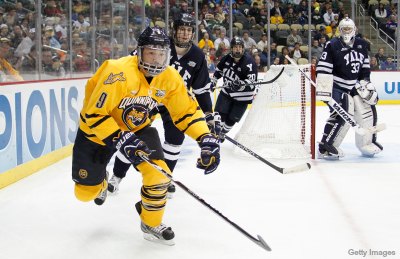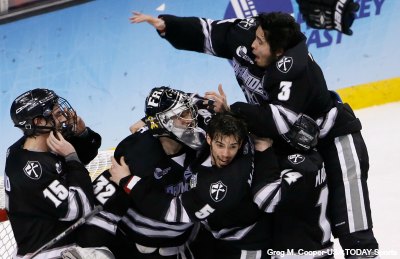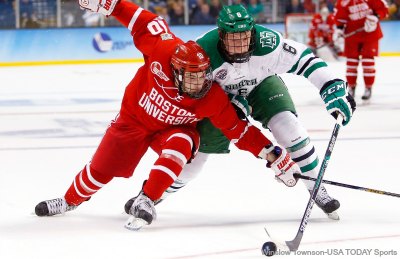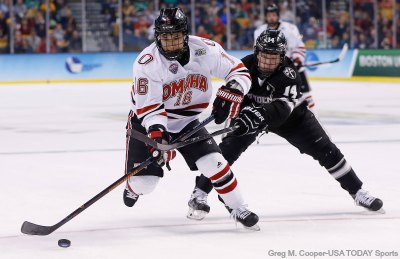College hockey has its juggernauts, just like any sport. Its Minnesotas and Michigans have legacies that parallel college basketball's Kentuckys and Kansases, or football's Nebraskas and, well, Michigans.
But for the small-but-successful programs in NCAA hockey, there isn't an obvious comparison in mainstream college sports. Schools like Quinnipiac and Bemidji State may not have any name recognition on a national scale, but when it comes to hockey, they're every bit the titan as the power-conference schools they play against.
Even more surprising: That trend seems to be on the rise. You'd think a deep-pocketed program like Michigan could outmuscle those smaller nagging programs. Yet it was knocked out of this year's NCAA hockey tournament one win away from the Frozen Four.
In the end, the Wolverines went as deep in the tournament as Ferris State, a humble university from Big Rapids, Michigan, that scored a big upset in its first regional game, setting the stage for a possible Frozen Four berth.

The kicker: That "big upset" came against St. Cloud State, a Minnesota-based program that ranked No. 2 in Division I hockey's RPI rankings. Ahead of them: Quinnipiac.
What's going on here? Why are small schools so much better than heavyweight universities trotting out their own hockey teams?
Here are some answers.
Hockey is an extremely regional sport
Look at a map of the 60 NCAA Division I hockey teams, and one thing is clear: Hockey fever has only infected portions of the United States. If you live in New England, you're probably a stone's throw away from a Division-I hockey team. It's not much different in portions of the Upper Midwest, where Minnesota, Michigan and Wisconsin are home to a number of prominent hockey programs.
But the college game has virtually no presence in warmer regions. The University of Alabama-Huntsville is a hockey anomaly, maintaining the only college team in the southeast part of the United States. West of Fargo, meanwhile, Division I hockey has three teams in Colorado, two in Alaska and none anywhere else.
So college hockey is far from a national activity. But its limited participation does not reflect the regional passion for the game.

Small programs are steeped in local pride
Despite its big upset of Saint Cloud State, Ferris State fell one game short of the Frozen Four, losing to Denver in the regional final. The Bulldogs experienced soaring highs and painful lows in the span of a couple days.
"The reality, I know I mentioned it to the guys, is 48 hours from now there will be quite a bit of joy," said Ferris State coach Bob Daniels after the loss. "We still have a conference title and NCAA banner, so there is a lot to be thankful for.
"Realistically, it's tough to say goodbye to the seniors. They have won a lot of games for us, two conference titles, two NCAA tournaments, two regional finals. It's really especially painful."
Painful for the hockey team, and painful for Ferris State fans at large. And why? Because of the question most readers are asking themselves right now: What the heck is Ferris State? Because in most regards, the small Michigan state school is anonymous on the broader college sports landscape. But hockey is different: Ferris State has reached the NCAA tournament three times since 2012, including a Frozen Four trip that same year.
Bulldogs fans do have a football team to support, but it plays in Division II. Hockey is an opportunity for the school to hang with major programs like Minnesota, Michigan and St. Cloud State.
But wait -- St. Cloud State? Surely, this is a typo? In fact, it is not. For similar reasons as Ferris State, St. Cloud State is committed to fielding a great hockey program. The team benefits from a passionate local hockey base and a long history playing the sport.

Before the Big Ten organized itself for hockey, St. Cloud State played in the same conference as Minnesota, and hockey games between the two schools drew high interest from fans across the state.
Meanwhile, the growth in popularity of basketball and football have created an opportunity for smaller schools to dominate other sports. Michigan, Michigan State, Minnesota and other large schools may all care about their hockey teams and their great hockey traditions. But there's no way hockey can compete with those football programs.
At Minnesota, despite some recent bowl appearances, the Golden Gophers football team is a traditional creampuff, while its hockey program is one of the most celebrated in NCAA history. But forced to choose between the two, there's no way the university would close shop on football and its massive revenue opportunities.
At Bemidji State, things are a little bit different. Hockey is one proving ground where the tiny university, which enrolls just more than 5,000 students annually, can compete with larger institutions on a national state. So the Beavers go all in on hockey, and their efforts were rewarded with a stunning Frozen Four berth in 2009.
Michigan has the most national championships with nine, but it hasn't won a title since 1998. In the meantime, Denver has won two. And four of the five past champions -- Minnesota-Duluth, Yale, Union and Providence -- do not play big-time college football. Boston College in 2012 was the exception.
The money isn't good enough to tempt larger schools
A lot of college hockey teams are able to turn a small profit for the school -- the best programs earn upwards of $5 million to $7 million in revenue, but even small schools like Colorado College report revenues in excess of $3 million. That's a decent chunk of change, but it pales to what major programs can earn through their football and basketball programs.
Meanwhile, schools that don't have a hockey team face additional expenses to start a program. Ignoring the cost of equipment and ice facilities, Title IX regulations alone would likely mean adding an additional women's sport. That extra cost has to be considered, and women's teams typically don't earn as much revenue as men's programs, which means their costs would have to be covered by the men's program.

Throw in the absent asset of a built-in hockey fan base, and most schools view hockey as a potential money pit, rather than an added revenue stream. Even as hockey increases in popularity among youth in warmer regions, with California players competing for teams in the Frozen Four, local colleges haven't shown any interest in creating new hockey programs.
College hockey's madness lives in basketball's shadow
Ferris State's upset of St. Cloud State is better than it might seem. The team entered the postseason ranked 29th out of 60 teams in NCAA Division I's RPI. Proportionally, that's a bigger upset than Michigan State losing to Middle Tennessee State in basketball.
Fans of college hockey will say that it's just as unpredictable and crazy as college basketball -- indeed, some would say it's even more chaotic than the traditional March Madness showcase.
"This tournament can rip your heart out," said St. Cloud State coach Bob Motzko after his team was upset by Ferris State. "Absolutely can rip your heart out."
Indeed, Huskies players were devastated and dejected by the upset. And that lack of predictability is what fans love about March Madness: It doesn't matter if you know who Florida Gulf Coast is, and in fact, it's better if you don't. Anonymous teams build their legacies through those stunning upsets.

But outside of the most committed hockey diehards, the sport doesn't get much attention. Part of it is the poor television coverage -- scheduling NCAA hockey during the NCAA men's and women's basketball tournaments is a recipe for disaster, but moving the championship tournament is also tricky.
Another problem might be the use of neutral sites to host the NCAA regional tournament games. Instead of following the lead of the NCAA women's basketball tournament, which has early rounds hosted by the top-seeded team in the bracket, hockey chooses neutral sites that fail to draw a large fan base.
This makes for a fair playing field, but it also dulls the excitement of the games.
There's no simple solution to increase college hockey's popularity across the country. Then again, maybe that's the beauty of the sport -- it's found a sweet spot where schools can turn a profit without being money-obsessed, and where small schools aren't outsized by economic disadvantages.
If anything, smaller schools have a slight advantage over larger programs: Their hockey teams are like families, and their traditions run deep.
"It's an amazing feeling, especially as a senior, [to make the Frozen Four]," said Denver University captain Grant Arnold. "I think about the tough losses that our class has had. I think about the seniors from last year and all the alumni around the country.
"Denver is a family, and I think about our school and I think about everyone."





